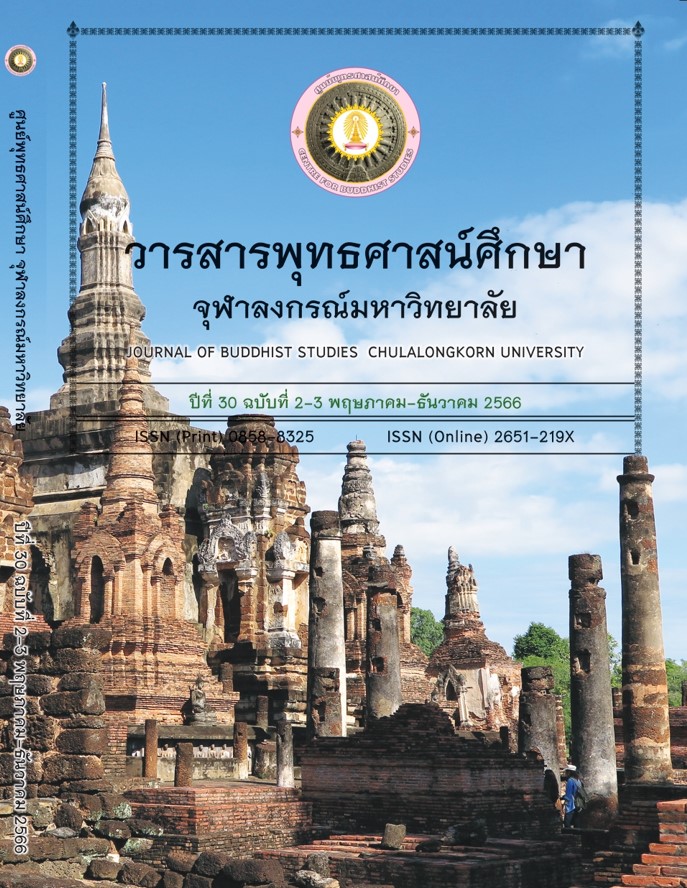Buddhist Principles and Public Welfare Rescue Group Operations Supported by Buddhist Institutions in Northern Thailand
Keywords:
public welfare operation, rescue groups, Buddhist institutions, the principles of dharmaAbstract
Socially engaged Buddhism is an attempt to adjust the role of Buddhist institutions in order to adapt to the changing ways of life in society. In line with this idea, this study examines how Buddhist principles are applied in public welfare operations of rescue groups supported by Buddhist institutions in three areas of northern Thailand. Qualitative data was obtained from interviews together with documentary studies and fieldwork. Thirty monks/laypeople who are involved in the public welfare operations of the rescue groups supported by Buddhist institutions participated in this study. The objectives of this study include analyzing the essence as well as the application of the principles of dharma in the public welfare operations of the rescue groups and examining the development and recommendation of policy for Buddhist volunteerism in the public welfare operations of the rescue groups according to Buddhist principles.
The research found that the core principles of dharma exist at the basic level in the thoughts or minds of these rescue groups in support of their voluntary effort in order to achieve maximum benefit within the context of Saṅghahadhura, which is service to society or serving the society with service mind. When performing their operations, such as rescuing effort, the groups apply the principles of dharma to their tasks in an orderly way: before, during, and after operations. With regard to the development and recommendation of policy for Buddhist volunteerism, the groups demonstrate the connection with Buddhist principles in determining their group’s mission and the development of Buddhist volunteerism, leading to the beginning of sustainable and efficient participation in the public welfare operations of the rescue groups.
Downloads
References
กรมการศาสนา. (2500). พระไตรปิฎกภาษาไทย ฉบับหลวง. (อนุสรณ์งานฉลอง 25 พุทธศตวรรษ). พระนคร: การศาสนา.
ชลวิทย์ เจียรจิตต์. (2560). ศาสนากับการพัฒนา (พิมพ์ครั้งที่ 2). ดีไซน์ ดีไลท์.
ชลวิทย์ เจียรจิตต์. (2565). สู่สังคมชาญชรา: นวัตกรรมทางสังคมกับการเสริมสร้าง เครือข่ายเพื่อการพัฒนาศักยภาพผู้สูงอายุในสังคมไทย. วารสารพัฒนา สังคม, 24(1), 49–67.
ชลวิทย์ เจียรจิตต์. (2566). พุทธนววิถี: บทเรียนระหว่างโควิดและเส้นทางสู่ชีวิต วิถีถัดไป (พิมพ์ครั้งที่ 3). พระนครศรีอยุธยา: สถาบันวิจัยพุทธศาสตร์ มหาวิทยาลัยมหาจุฬาลงกรณ์ราชวิทยาลัย.
ชลวิทย์ เจียรจิตต์, และสายชล ปัญญชิต. (2565). สังฆะ สังคม สุขภาวะ: บทวิเคราะห์ทางสังคมวิทยากับการสร้างสุขภาวะวิถีพุทธขององค์กรพระพุทธศาสนา (พิมพ์ครั้งที่ 2). สํานักงานกองทุนสนับสนุนการ สร้างเสริมสุขภาพ.
ชลวิทย์ เจียรจิตต์, และสายชล ปัญญชิต. (2566). ปฏิบัติการทางศาสนากับการ พัฒนาสุขภาวะวิถีพุทธในสังคมไทย: มุมมองทางสังคมวิทยา. วารสารธรรมศาสตร์, 42(2), 38–53.
ณัชพล ศิริสวัสดิ์. (2564). การศึกษาเครือข่ายงานสาธารณสงเคราะห์ของคณะสงฆ์ ไทยในสถานการณ์การแพร่ระบาดของโรคติดเชื้อไวรัสโคโรนา 2019 (โควิด-19). วารสาร มจร สังคมศาสตร์ปริทรรศน์, 10(3), 264–277.
ธันนิกานต์ สูญสิ้นภัย ชยันตราคม. (2561). เครือข่ายการพัฒนาสังคมและ สิ่งแวดล้อม รูปแบบ กระบวนการ และการจัดการของคณะสงฆ์ จังหวัดร้อยเอ็ด. วารสาร มจร การพัฒนาสังคม, 3(2), 1–12.
ธานี สุวรรณประทีป, วุฒินันท์ กันทะเตียน, และกณภัทร ไตรพรพัฒนา. (2566). 3 ไตร 3 โอวาท พัฒนาหน่วยอบรมประชาชนประจําตําบล (อ.ป.ต.). นนทบุรี: นิติธรรมการพิมพ์.
ธานี สุวรรณประทีป, วุฒินันท์ กันทะเตียน, และพงษ์พัฒน์ ใหม่จันทร์ดี. (2565). รูปแบบการเสริมสร้างสุขภาวะวิถีพุทธเพื่อป้องกันการดื่มเครื่องดื่ม แอลกอฮอล์และการสูบบุหรี่ในเยาวชนไทย. วารสารพุทธศาสน์ศึกษา จุฬาลงกรณ์มหาวิทยาลัย, 29(2), 54–74.
ประทุม อังกูรโรหิต. (2554). สถาบันทางพระพุทธศาสนากับงานสังคมสงเคราะห์ ในประเทศไทย. วารสารพุทธศาสน์ศึกษา จุฬาลงกรณ์มหาวิทยาลัย, 18(3), 31–38.
ปรีชา ช้างขวัญยืน, และสมภาร พรมทา (บรรณาธิการ). (2547). มนุษย์กับศาสนา. กรุงเทพฯ: โครงการเผยแพร่ผลงานวิชาการ คณะอักษรศาสตร์ จุฬาลงกรณ์มหาวิทยาลัย.
พระพรหมคุณาภรณ์ (ป.อ. ปยุตฺโต). (2555). พจนานุกรมพุทธศาสตร์ ฉบับประมวลธรรม (พิมพ์ครั้งที่ 23). กรุงเทพฯ: สํานักพิมพ์ผลิธัมม์.
พระมหาสุทิตย์ อาภากโร. (2558). พระพุทธศาสนากับการพัฒนาสังคม. พระนครศรีอยุธยา: มหาจุฬาลงกรณ์ราชวิทยาลัย.
พัฒนา กิติอาษา. (2550). ความเป็นอนิจจังของพุทธไทย: จากสิ่งตกทอดผูกพัน จากอดีต ถึงความทันสมัย และการแตกตัวออกเป็นเศษเสี่ยง. วารสารสังคมศาสตร์ มหาวิทยาลัยเชียงใหม่, 19(1), 131–180.
พินิจ ลาภธนานนท์. (2564). สังฆะ สาธารณสงเคราะห์ สังคมสุขภาวะ. นนทบุรี: นิติธรรมการพิมพ์.
พินิจ ลาภธนานนท์, และคณะ. (2562). แนวคิดพุทธศาสนาเพื่อสังคม สังคหธุระ และสาธารณสงเคราะห์วิถีพุทธ. นนทบุรี: นิติธรรมการพิมพ์.
พินิจ ลาภธนานนท์, สายชล ปัญญชิต, และภูเบศ วณิชชานนท์. (2564). สังคมวิทยา ของพระพุทธศาสนาเพื่อสังคม: บทวิเคราะห์ว่าด้วยงานสาธารณสงเคราะห์ วิถีพุทธของคณะสงฆ์ไทย. วารสาร มจร สังคมศาสตร์ปริทรรศน์, 10(2), 25–38.
พิรญาณ์ แสงปัญญา, และพินิจ ลาภธนานนท์. (2564). พุทธศาสนาเพื่อสังคม: บทบาทพระสงฆ์ด้านงานสาธารณสงเคราะห์ กรณีศึกษาพระราชธรรมนิเทศ (พระพะยอม กลฺยาโณ) วัดสวนแก้ว จังหวัดนนทบุรี. วารสาร มหาจุฬานาครทรรศน์, 8(3), 288–302.
พุทธทาสภิกขุ. (2532). ใจความสําคัญแห่งคู่มือมนุษย์. กรุงเทพฯ: ธรรมสภา. ภาวิกา ศรีรัตน์บัลล์. (2566). Sociology of Death – ความหมายของความตาย. เชียงใหม่: สํานักงานการวิจัยแห่งชาติ.
รัตนา บุญมัธยะ โตสกุล. (2550). ชาวนาอีสาน ชาติไทย และการพัฒนาไปสู่ความ ทันสมัย. วารสาร สังคม ศาสตรสังคมศาสตร์, 19(1), 69–129
รัชพล ศิริรัตน์พิริยะ. (2561). หลักพุทธธรรมเพื่อการปฏิบัติงานอาสาสมัครกู้ชีพและ บรรเทาสาธารณภัย. วารสาร มจร นครน่านปริทรรศน์, 2(2), 117–130.
วัชระ งามจิตรเจริญ. (2552). แนวคิดในการใช้พุทธธรรมเพื่อการดําเนินการ ทางเศรษฐกิจในสังคมทุนนิยม. วารสารพุทธศาสน์ศึกษา จุฬาลงกรณ์ มหาวิทยาลัย, 16(1), 52–76.
วุฒินันท์ กันทะเตียน. (2563). โครงการศึกษาองค์ความรู้ด้านสาธารณสงเคราะห์ ในคัมภีร์พระพุทธศาสนา. วารสารสันติศึกษาปริทรรศน์ มจร, 8(1), 65–74.
สมเด็จพระพุทธโฆษาจารย์ (ป. อ. ปยุตฺโต). (2562). พุทธธรรม ฉบับปรับขยาย (พิมพ์ครั้งที่ 53). กรุงเทพฯ: มหาวิทยาลัยเอเชียอาคเนย์.
อมรา พงศาพิชญ์. (2541). วัฒนธรรม ศาสนาและชาติพันธุ์: วิเคราะห์สังคมไทย แนวมานุษยวิทยา (พิมพ์ครั้งที่ 5). สํานักพิมพ์แห่งจุฬาลงกรณ์ มหาวิทยาลัย.
อมรา พงศาพิชญ์, และคณะ. (2546). องค์กรสาธารณประโยชน์ในประเทศไทย. กรุงเทพฯ: สถาบันวิจัยสังคม จุฬาลงกรณ์มหาวิทยาลัย.
อารตี อยุทธคร. (2565). ลัทธิพิธีพระพิฆเนศในเชียงใหม่: ความศักดิ์สิทธิ์ ผัสสะและ สื่อสังคมออนไลน์. เชียงใหม่: ศูนย์อินเดียศึกษา มหาวิทยาลัยเชียงใหม่.
Gez, Y.N. (2018). Traditional Churches, Born Again Christianity, and Pentecostalism Religious Mobility and Religious Repertoires in Urban Kenya. Cham: Palgrave Macmillan.
Giddens, A. (1984). The Constitution of Society: Outline of the Theory of Structuration. Cambridge: Polity Press.
Lapthananon, P. (2012). Development Monks in Northeast Thailand. Kyoto: Kyoto University Press.
Munson, H. (1986). Geertz on religion: The theory and the practice. Religion, 16(1), 19–32.
Queen, C.S. (2000). Introduction: A New Buddhism. In Engaged Buddhism in the West, Christopher Queen (ed.), pp.1–34. Somerville, MA: Wisdom Publications.
Downloads
Published
How to Cite
Issue
Section
License
Copyright (c) 2024 Chulalongkorn University Centre for Buddhist Studies

This work is licensed under a Creative Commons Attribution-NonCommercial-NoDerivatives 4.0 International License.
บทความที่ได้รับการตีพิมพ์เป็นลิขสิทธิ์ของศูนย์พุทธศาสน์ จุฬาลงกรณ์มหาวิทยาลัย
ข้อความที่ปรากฏในบทความแต่ละเรื่องในวารสารวิชาการเล่มนี้เป็นความคิดเห็นส่วนตัวของผู้เขียนแต่ละท่านไม่เกี่ยวข้องกับศูนย์พุทธศาสน์ จุฬาลงกรณ์มหาวิทยาลัย และคณาจารย์ท่านอื่นๆในมหาวิทยาลัยฯ แต่อย่างใด ความรับผิดชอบองค์ประกอบทั้งหมดของบทความแต่ละเรื่องเป็นของผู้เขียนแต่ละท่าน หากมีความผิดพลาดใดๆ ผู้เขียนแต่ละท่านจะรับผิดชอบบทความของตนเองแต่ผู้เดียว






